Travelling back in time, through the Incense Route, to Tayma
The desert oasis holds archaeological finds that speak of the rich history of Saudia Arabia
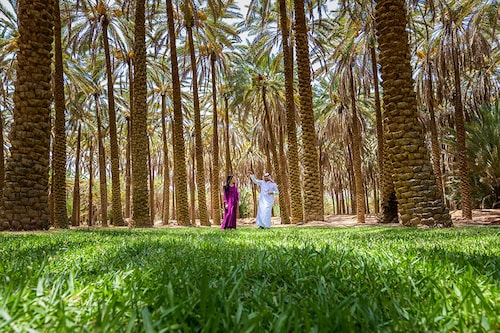

Tayma comes as a bonus to me after a gratifying visit to AlUla in Saudi Arabia. A desert oasis of yore and an emerging archaeological hub now, Tayma—191 km from AlUla on the way to Tabuk airport—boasts its standing in ancient Arabian history as one of the oldest human settlements in Saudi Arabia.
As mentioned in the Hebrew Bible, Tayma’s biblical moniker seems to be Tema, son of Ishmael, after whom the land of Tema is named. Excavations in Tayma expose artefacts and monuments that shed light on the depth and complexity of the people who lived and thrived in this region thousands of years ago. A treasure-trove of history, Tayma has been a seat of prestige and power since it was strategically placed on the ancient Incense Route and has been a halting place for caravans crossing Arabia and a sister oasis to AlUla along this route. Tayma was also once the residence of Nabonidus, the last native King of Babylon. During the first century AD, Tayma was a wealthy Jewish settlement with many wells and other water sources.
As we stop at the visitor centre, the tour guides welcome us warmly with dates and kahwa. Our host Suleiman says, “The team of Saudi men and women have been mentored by archaeologists and trained by international museums to connect every visitor to the stories of this extraordinary open-air gallery. Many are from nearby towns and speak beautifully of their own connections to this place and its heritage."
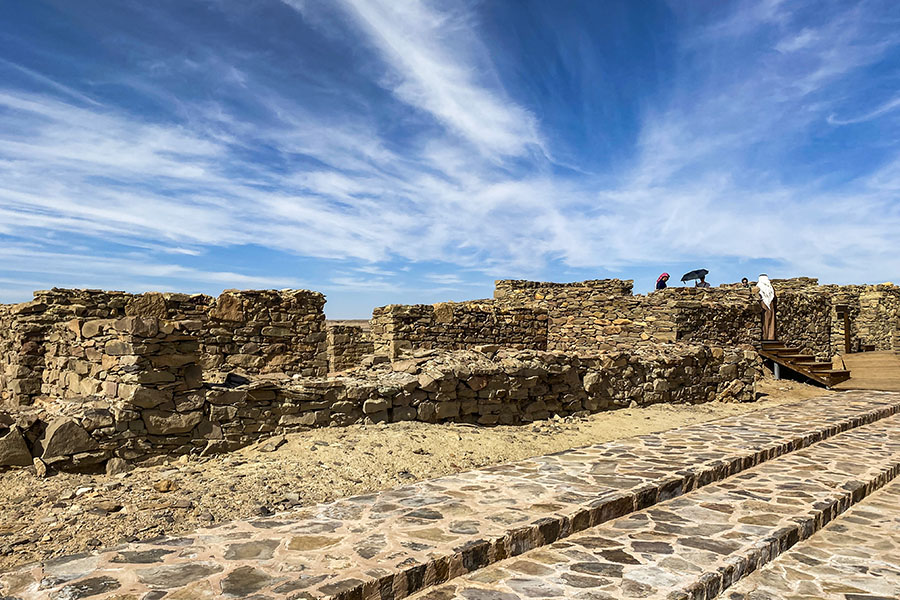 Iron Age temple complex overlooking a vast landscape where there was once an ancient lake, and the remains of structures dating back to the Iron Age. Image: Vijaya Pratap
Iron Age temple complex overlooking a vast landscape where there was once an ancient lake, and the remains of structures dating back to the Iron Age. Image: Vijaya Pratap
Fatima, our tour guide, leads us to the 3,000-year-old Iron Age temple complex overlooking a vast landscape where there was once an ancient lake, and the remains of structures dating back to the Iron Age. It had been buried beneath shifting sands for hundreds of years till it was rediscovered in the 1970s when some remarkable treasures were found in its ruins. A place of power, the complex was never used as a royal residence as it was primarily religious and it was altered and expanded over many centuries. Two discoveries were made in a room within the sanctuary: The Al Hama Stele and the Al Hama Cube, suggesting Babylonian influences and links between Tayma and civilisations thousands of miles away.
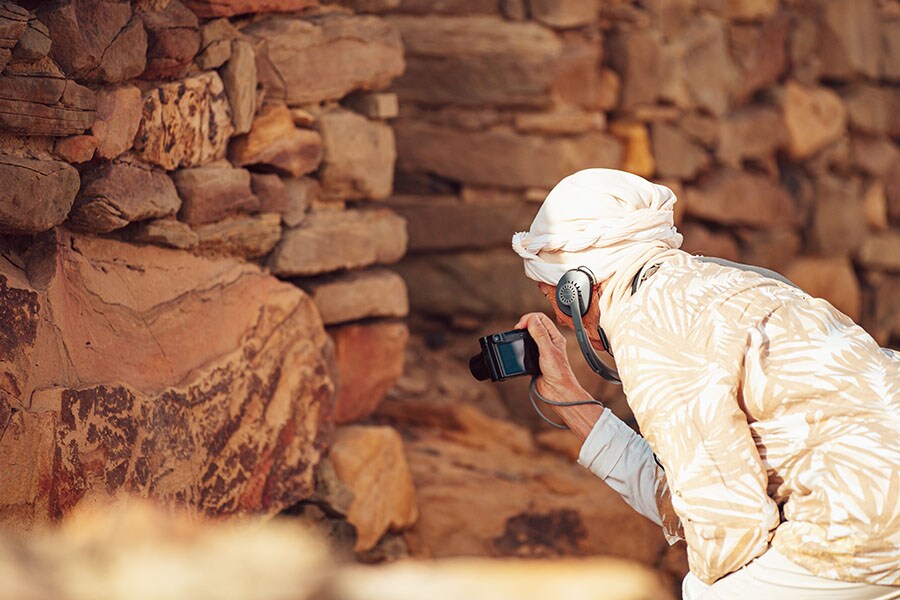 Tourist taking photo at the Ancient temple of Salm Image: Courtesy RCU
Tourist taking photo at the Ancient temple of Salm Image: Courtesy RCU
Mentioned in the Bible, the Tayma Stone is over 2 millennia old and currently on display at the Louvre Museum in France. Found by Charles Huber, a French explorer, among the ruins of a building near the Bir Haddaj, it proved to be an ancient artefact of unimaginable importance. One of the rarest archaeological finds ever to come out of the Arabian Peninsula, Tayma Steele is a limestone stone slab, 110 cm long, 43 cm wide, 12 cm thick. It weighs 150 kg, and has a 23-line inscription in Aramaic (a Semitic language of 800 to 600 BC). On the front face is carved an inscription declaring how the old gods of Tayma are welcoming a new god into their midst. The other faces are adorned with carved images, some of which suggest that as an important destination along the Incense Road, Tayma had connections with powerful Egyptian and Assyrian civilisations hundreds of miles away. Other carvings on the stone include an imposing regal figure holding a staff, and another man, probably a priest, reaching out to him while making an offering.
 In the midst of Tayma city is an ancient well called Bir Haddaj, now a popular tourist attraction. Image: Courtesy RCU
In the midst of Tayma city is an ancient well called Bir Haddaj, now a popular tourist attraction. Image: Courtesy RCU
The Assyrian inscriptions described Tayma as a rich city of water wells: In the midst of Tayma city is an ancient well called Bir Haddaj, now a popular tourist attraction. A historic site of global importance, this well was immortalised in poetry, literature and song. Bir Haddaj reportedly dates back to the Babylonian presence in the region over 2,500 years ago: It was filled in when the town was abandoned in the 5th century BC, and supposed to have been uncovered by a local Jewish man, Suleiman Al Gonaim, who restored it to a functional state. Consisting of yellow stone blocks and plants and algae growing on the walls, the well is perhaps a remarkable example of ancient engineering during that time period. With a head circumference reaching 65 m and a depth of over 12 m, it is considered to be one of the largest historic wells in the world and the oldest in the region. In continuous use, the current wheels and pulleys date from improvements made by King Saud in the 1950s.
An impressive sight, we watch curiously as camels go in cycles to pull water from below this hydraulic wonder. The camel drivers have a rhythmic call as the animals saunter in their tracks, while the leather bags are lowered with the help of pulleys, filled with water and drawn back from the cistern.
As we walk through rows of date palms laden with fruit, interspersed with orchards full of luscious orange, Fatima explains how the ancient settlers discovered an unusual geographical feature in this land called ‘aquifer’ (that allows water lying in reservoirs deep underground to seep to the surface where it either outlets naturally as a spring or is accessed by the digging of a well) and cashed on it by creating numerous wells and water courses to nurture their crops and date plantations. A lush oasis in the middle of the desert made Tayma a place of power and importance and its abundant water supported the settlers to connect with various civilisations.
Frankincense and myrrh, both of which grew in Southern Arabia had great value in the ancient world used in the preparation of medicines, and cosmetics, in the embalming of Egyptian mummies and in religious ceremonies, their price was often higher than gold. The caravans passing through Tayma carried these and other valuable goods like gemstones and spices, bringing wealth to Tayma.
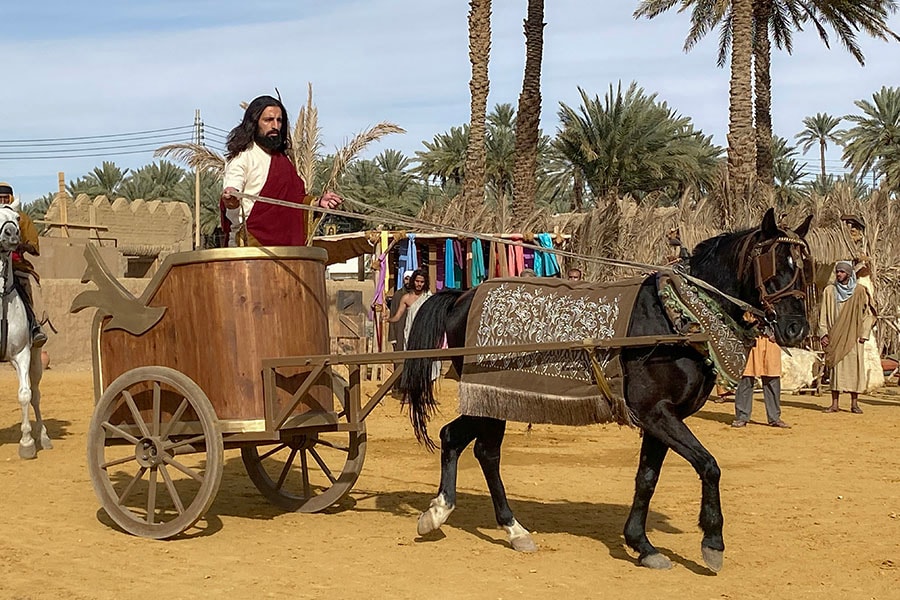 Ancient Kingdoms", an enthralling re-enactment show, narrating the story of Tayma through music and performing arts. Image: Vijaya Pratap
Ancient Kingdoms", an enthralling re-enactment show, narrating the story of Tayma through music and performing arts. Image: Vijaya Pratap
As part of the ‘Tayma Live’ show presented by the Royal Commission for AlUla, we watch a traditional Arab dance called ‘Ardah’ performed by men: With two rows of men opposite each other wielding swords, they move rhythmically to the accompaniment of drums and singing a display of male valour, storytelling and stimulation.
Afterwards, we reach a re-created market in a huge open land with shops filled with traditional goods like grains, pots and pans, huge woven baskets etc. Earphones are handed to us to listen to the commentary of ‘Ancient Kingdoms’, an enthralling re-enactment show, narrating the story of Tayma through music and performing arts. The booming voice speaks of the history of the city as caravans of camels arrive carrying goods and a procession of ancient Arabs in period costumes follows, men carrying swords, axes, and spears while warriors on horseback gallop closely behind as part of the King Nabonidus Parade.
Around 552 BC, the Babylonian king, Nabonidus, the father of biblical Belshazzar, conquered Tayma and spent 10 years here in prayer and in search of prophecies. Women clad in long robes swirl clouds of incense in worship, creating a mystical ambience. The open market briefly becomes a battleground with the entry of Queen Shamsi and reverberates with the clashes of swords, and soldiers fighting fierce battles. The horse-drawn chariot takes me back to the times of Ben-Hur and the famous chariot race!
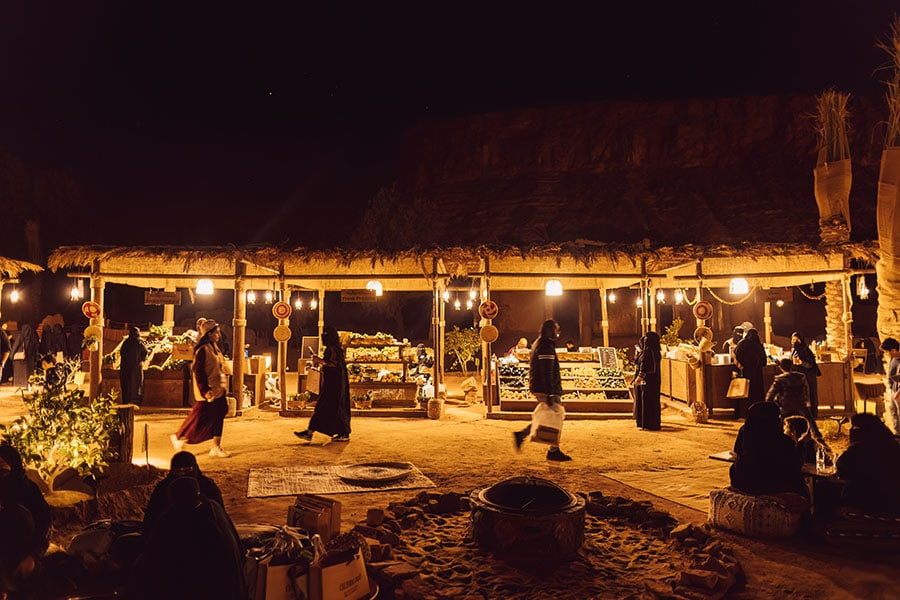 Nurtured by numerous wells and watercourses, Tayma’s crops and orchards produce fresh vegetables and fruits that fill the local food markets. Image: Courtesy RCU
Nurtured by numerous wells and watercourses, Tayma’s crops and orchards produce fresh vegetables and fruits that fill the local food markets. Image: Courtesy RCU
We walk to the 300-year-old Souq Al Najm, a historic street where homes were used as shops. The board says, ‘Leave your camel outside’. Seeing our puzzled look, Fatima explains pointing to the small tunnel next to the main gate, “The main gate of the souk was closed at night for security reasons: Anyone wishing to enter Souq Al Najem during the hours of darkness had to crawl through this hole, having first left their weapons and camel outside. The street was enclosed in high walls and was wide enough to allow only two donkeys, making it difficult for a large attacking force to charge down a tiny, narrow space."
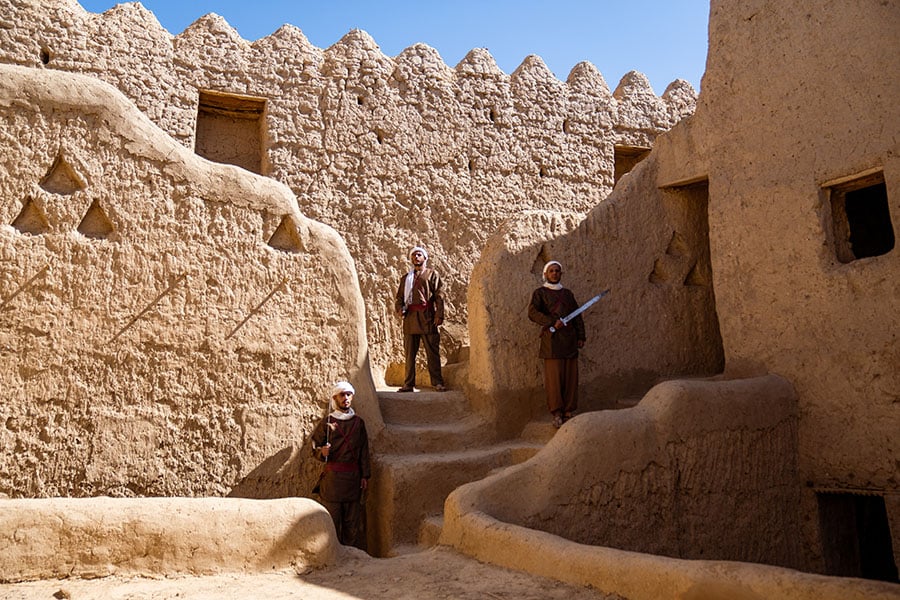 "The Palace Guest" is an immersive live show that offers a true insight into the history of Qasr Ibn Rumman. Image: Courtesy RCU
"The Palace Guest" is an immersive live show that offers a true insight into the history of Qasr Ibn Rumman. Image: Courtesy RCU
‘The Palace Guest’ is an immersive live show that offers a true insight into the history of Qasr Ibn Rumman, a castle from the 1700s, with a palace added a century ago it served as the governor’s workplace and home. As guests of the palace, we are received by liveried servants and offered dates, kahwa and other traditional sweets.
Built in the Najd architectural style, the main door made of Tamarisk wood with iron rods (brought from Hejaz railways in AlUla) to close and lock the door and ‘ghettelas’ from where the enemy can be spotted and shot down, the Qasr Ibn Rumman Palace (built of mud) has many interesting features besides 4- to 5-feet thick walls. We are taken around the ‘open to the sky’ summer mosque and the fully closed winter mosque the governor’s Majlis, a huge sitting room with a high ceiling, tiny triangular windows to send out smoke during cooking in the summers and bonfires during winter square windows for ventilation. We watch the governor’s court in session where grievances are heard and disputes are solved.
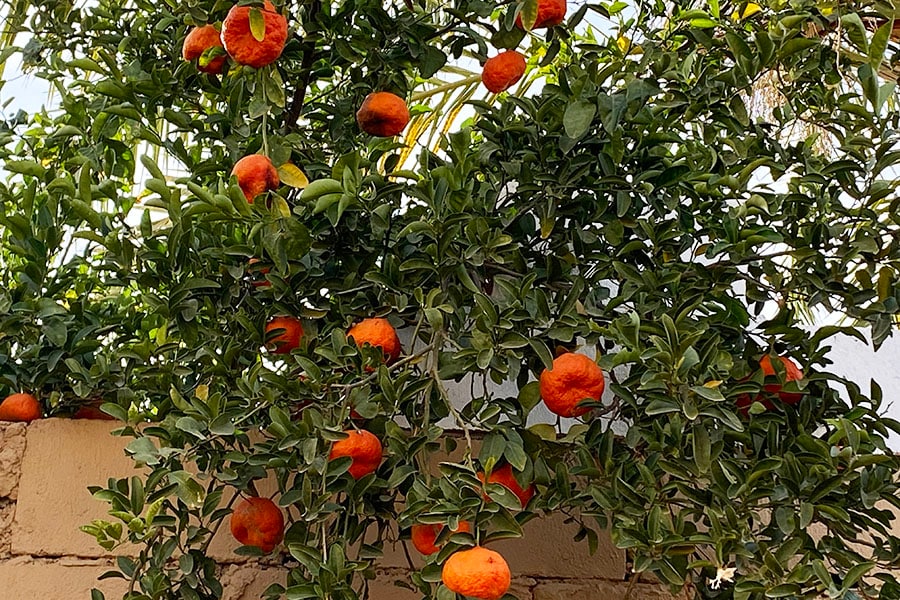 Tayma’s orange orchards are a visual delight! Trees hang heavy, laden with luscious fruit, tempting the passers by. Image: Vijaya Pratap
Tayma’s orange orchards are a visual delight! Trees hang heavy, laden with luscious fruit, tempting the passers by. Image: Vijaya Pratap
In front of the Bir Haddaj, at an open-air restaurant called Mirzam, our lunch comprises classic Saudi Arabian dishes topped with not one, but three desserts! When asked to choose a drink, I fondly look at the orange tree laden with fruit, gracefully falling over the compound wall and place an order for fresh orange juice, pointing to the tree, almost suggesting that I want the oranges to be plucked and juiced. The waiter nods with a smile and says he will juice absolutely fresh fruits, but not from the neighbour’s tree. My companions and I burst out laughing.
Tayma’s oasis has been generously giving fresh water and fruit for centuries, quenching the thirst of travellers and filling their stomachs while Bir Haddaj stands as a silent witness to the times gone by and civilisations that lived and left.
First Published: Mar 22, 2024, 15:57
Subscribe Now